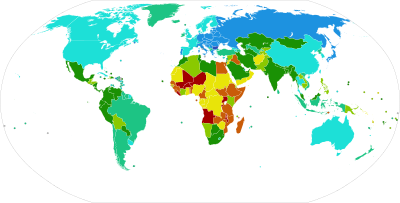
Back የተፈጥሮ ጭማሪ Amharic معدل الزيادة الطبيعية Arabic Естествен прираст Bulgarian Creixement vegetatiu Catalan Přirozený přírůstek Czech Geburtenbilanz German Natura kresko Esperanto Crecimiento natural Spanish Loomulik iive Estonian Berezko hazkunde Basque

| ≥ 30 25 – 29.99 20 – 24.99 15 – 19.99 | 10 – 14.99 5 – 9.99 0 – 4.99 -5 – -0.01 | < -5 Data unavailable |
In Demography, the rate of natural increase (RNI), also known as natural population change, is defined as the birth rate minus the death rate of a particular population, over a particular time period.[1] It is typically expressed either as a number per 1,000 individuals in the population[2] or as a percentage.[3] RNI can be either positive or negative. It contrasts to total population change by ignoring net migration.
This RNI gives demographers an insight into how a region's population is evolving, and these analyses can inform government attempts to shape RNI.
- ^ Rogers, Luke; Borsella, Peter (March 24, 2016). "Growth or Decline: Understanding How Populations Change". United States Census Bureau.
- ^ "World Population Prospects". United Nations Department of Economic and Social Affairs.
- ^ "Estimates, 1950 - 2020: Annually interpolated demographic indicators - Rate of natural increase (per 1,000 population)". Our World In Data.
© MMXXIII Rich X Search. We shall prevail. All rights reserved. Rich X Search